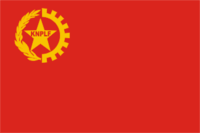Karenni National People's Liberation Front
The Karenni National People's Liberation Front (KNPLF; Burmese: ကရင်နီလူမျိုးပေါင်းစုံ ပြည်သူ့လွတ်မြောက်ရေးတပ်ဦး) was a communist insurgent group active in Kayah State, Myanmar (Burma). It agreed to become a government-sponsored border guard force on 8 November 2009.[3]
| Karenni National People's Liberation Front | |
|---|---|
ကရင်နီလူမျိုးပေါင်းစုံ ပြည်သူ့လွတ်မြောက်ရေးတပ်ဦး Participant in the Internal conflict in Myanmar | |
 Flag of the Karenni National People's Liberation Front | |
| Active | 1978–2009 |
| Ideology | Karenni nationalism Communism[1] |
| Leaders | Sandar Shwe War |
| Headquarters | Pankan village, Loikaw Township[2] |
| Area of operations | Kayah State |
| Size | 4,000[3] |
| Allies | State allies
Non-state allies
|
| Opponent(s) | State opponents
Non-state opponents |
| Battles and war(s) | Internal conflict in Myanmar |
History
The KNPLF was formed in 1978, when a group of left-wing fighters split from the Karenni Army due to ideological differences. The group maintained close ties with the Communist Party of Burma (CPB), receiving training, supplies, and armed support from the group until the latter's disarmament in 1989.[3]
In 1989, a ceasefire deal was negotiated between the State Law and Order Restoration Council (SLORC) and the KNPLF, which was finalised in 1994.[3] The group had since helped government soldiers combat other armed insurgent groups, most notably the Karenni Army, and on 8 November 2009, the group agreed to transform into a "border guard force".[4]
The KNPLF has been accused of using child soldiers and landmines in the past,[5] with one child soldier named Koo Reh at age 13 saying:
I was watching the film [in the cinema], and he [the recruiter] sat and talked to me. He said if I joined I would be happy and receive a salary and uniform. I do not remember his name but he was from KNPLF. I agreed to join. He spoke to many people in the cinema, one by one, 20 or 25 people, adults, women, boys. About six people went with him. The older ones were 16 or 17, the younger ones 11, 12 or 13. I went home but didn't tell my mother, then I went with him.[6]
References
- Beng, Ooi Kee (2014). ISEAS Perspective: Selections 2012-2013. Institute of Southeast Asian Studies. p. 107. ISBN 978-981-4519-26-7. Retrieved 11 May 2020.
- "KNPLF celebrates 25 years of ceasefire in Loikaw". Ministry Of Information. Myanmar Ministry of Information. Retrieved 11 May 2020.
- "Karenni National People's Liberation Front". Archived from the original on 10 May 2017. Retrieved 27 February 2016.
- Murray, Lucy; Byardu, Beh Reh (25 March 2005). "Karenni rebels dig in for last stand". Asia Times. Retrieved 29 November 2018.
- "Geneva Call - Karenni National Peoples Liberation Front (KNPLF)".
- "Sold to be Soldiers: The Recruitment and Use of Child Soldiers in Burma: VI. Child Soldiers in Non-State Armed Groups". www.hrw.org. Human Rights Watch. Retrieved 29 November 2018.